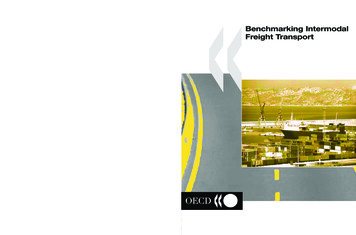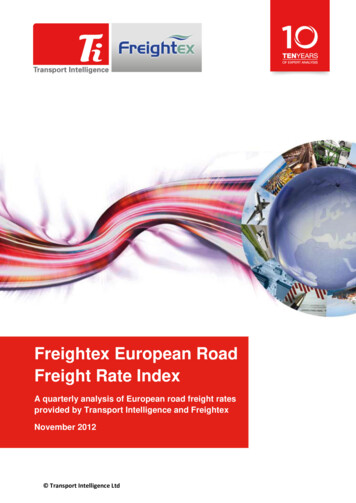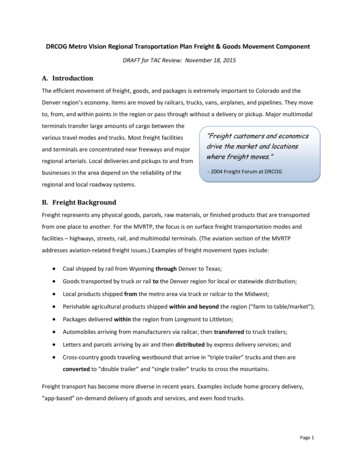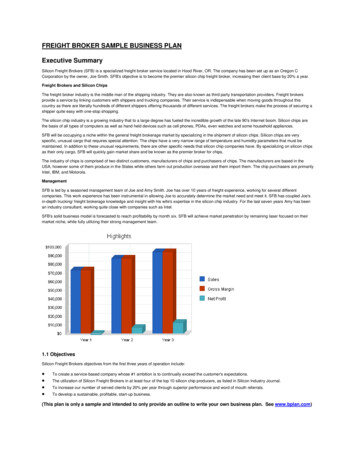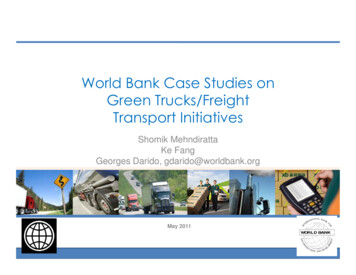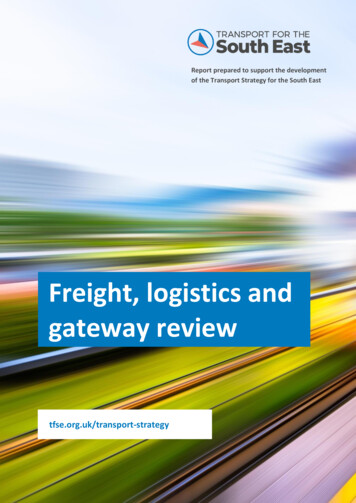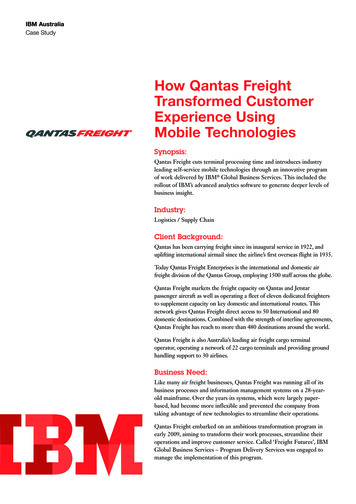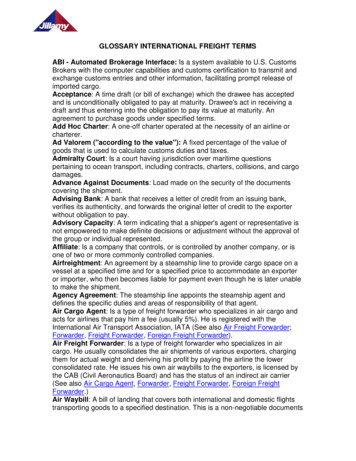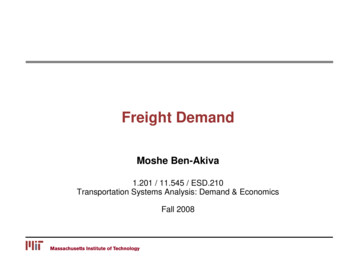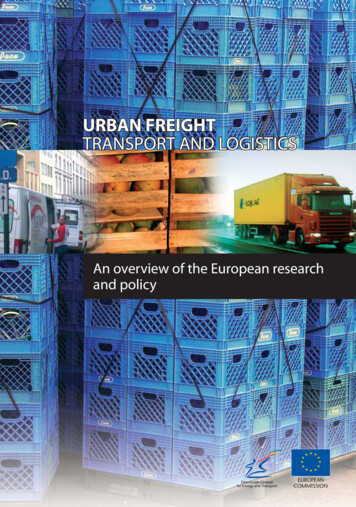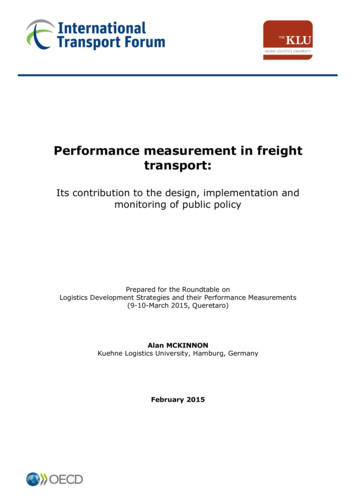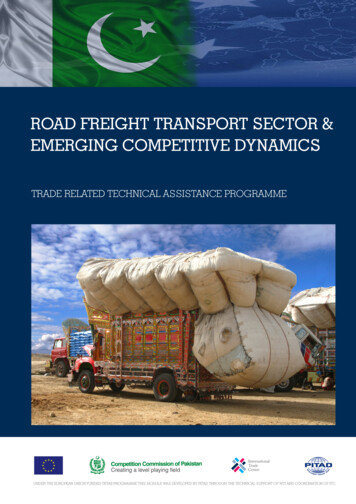
Transcription
ROAD FREIGHT TRANSPORT SECTOR &EMERGING COMPETITIVE DYNAMICSTRADE RELATED TECHNICAL ASSISTANCE PROGRAMMEUNDER THE EUROPEAN UNION FUNDED TRTAII PROGRAMME THIS MODULE WAS DEVELOPED BY PITAD THROUGH THE TECHNICAL SUPPORT OF WTI AND COORDINATION OF ITC.
Cover photos: Thinkstock.comAddress:Trade Related Technical Assistance (TRTA II) Programme,Programme Management Office (PMO), 7th Floor, Serena Business Complex,Khayaban-e-Suharwardy, Sector G-5/1, Islamabad, PakistanTelephone: 92 51 8354 810Fax: 92 51 2600 apakistan.orgFor enquiries and further details about Component 1 contact: Khalid Hanif, Programme Officer(Trade Policy), International Trade Centre (ITC), EU funded TRTA II programme, Islamabad, Email:hanif@intracen.org
ROAD FREIGHTTRANSPORT SECTOR ANDEMERGING COMPETITIVEDYNAMICS
ROAD FREIGHT TRANSPORT SECTOR AND EMERGING COMPETITIVE DYNAMICSThe study was commissioned under Component 1 of the European Union (EU) funded TradeRelated Technical Assistance (TRTA-II) programme. The TRTA II programme is implemented bythe United Nations Industrial Development Organization (UNIDO) in collaboration with theInternational Trade Centre (ITC) and World Intellectual Property Organization (WIPO). TheComponent 1 is about trade policy capacity building and is implemented by the International TradeCentre (ITC).ii
ROAD FREIGHT TRANSPORT SECTOR AND EMERGING COMPETITIVE DYNAMICSTABLE OF CONTENTSINTRODUCTION . 1STRUCTURE OF ROAD FREIGHT IN PAKISTAN . 3PAKISTAN AUTOMOTIVE MANUFACTURERS ASSOCIATION (PAMA) . 3NUMBER OF REGISTERED TRUCKS . 5FLEET COMPOSITION AND TECHNOLOGY . 7TRUCKING COMPANIES IN PAKISTAN . 8LARGE FLEET OPERATORS . 9FREIGHT RATE . 10TIME TAKEN . 11TYPE OF COMMODITIES TRANSPORTED BY TRUCKS. 11TRANSPORT OF AGRI-PRODUCTS . 12MODE OF PAYMENT . 12USE OF MODERN TECHNOLOGIES TO IMPROVE AND ENHANCE SERVICES . 13TRUCKING ASSOCIATIONS . 13MAJOR OBSTACLES FOR TRUCKING . 13PAKISTAN RAILWAYS (PR) - NATURAL COMPETITOR OF ROAD FREIGHT . 14FREIGHT FLEET OF PR. 14TYPE OF COMMODITIES CARRIED BY FREIGHT OPERATIONS OF PR . 16REASONS FOR LOSING GROUND TO ROAD FREIGHT. 16TIME TAKEN . 17TOWARDS THE “ERA OF CO-MODALITY”. 17PAKISTAN A NATURAL CORRIDOR FOR TRANSIT TRADE . 19AFGHANISTAN PAKISTAN TRANSIT TRADE AGREEMENT (APTTA) . 20TRADE WITH INDIA . 22TRADE WITH CHINA . 24CONCLUSION. 28BIBLOGRAPHY . 30Figure 1: Trend of total trucks produced . 4Figure 2: Trucks by make in Pakistan . 4Figure 3: Total production of light commercial vehicles in Pakistan . 5Figure 4: Production of light commercial vehicles by make in Pakistan . 5Figure 5: Increase of registered trucks in Pakistan . 6Figure 6: Total number of trucks on road in Pakistan . 7Figure 7: Pakistan trucks’ fleet composition . 7Figure 8: Trucking companies in Pakistan by size . 9Figure 9: Share of road freight trips by commodity type . 11Figure 10: Reasons for damage to perishable items . 12Figure 11: Comparative evolution of rail and road freight . 14Figure 12: Total Pakistan railways freight fleet . 15Figure 13: Evolution of Pakistan railways total freight carried . 15Figure 14: Pakistan railways commodity wise freight carried (tons) . 16Figure 15: Trade between Pakistan and Afghanistan in USD million . 21Figure 16: Trade between Pakistan and India in USD million . 23Figure 17: Evolution of the Pakistan China trade in USD billion . 25iii
ROAD FREIGHT TRANSPORT SECTOR AND EMERGING COMPETITIVE DYNAMICSTable 1: Composition of trucks y Axle configuration . 3Table 2: Registered number of trucks in Pakistan . 6Table 3: Evolution of Pakistan Railways freight transportation . 17Table 4: Approximate distances in Pakistan . 18Table 5: Transit trade between Pakistan and Afghanistan in USD million. 22Table 6: Afghan goods in transit to India . 22Table 7: Number of trucks at Wagha . 23Table 8: Major items of imports and export between Pakistan and India in the Financial Year 2013-14. 23iv
ROAD FREIGHT TRANSPORT SECTOR AND EMERGING COMPETITIVE DYNAMICSINTRODUCTIONThe transport sector plays a pivotal role in enhancing the global competitiveness of an economy andas well as in contributing to the efficient functioning of the supply chain, domestically. Efficient1transport and telecommunication network reduces production and transaction cost in poor regionswhich serves as stimulus for domestic commerce. There is a positive correlation between global trade2competitiveness and an efficient transport sector.Growing economic interdependence through an increasing volume and variety of cross-bordertransactions has resulted in increasing the importance of the transport sector. The Transport sectorhas the ability to potentially raise the economic growth of developing regions and lead to a shift ofproduction activities to these countries. Commonly considered as one of the driving forces ofeconomic growth and social development, Transport is central and functions as an enablingmechanism for any economy.Strong logistics and transportation services can enhance the competitiveness of an economy while,inefficient supply chains through high transport and logistics costs could impede export and importflows which may increase cost for firms, especially those competing in the export market.The Logistics sector is estimated at 14% of the global GDP (10-30%).Direct transport costs are3between 30-40% of all logistics costs; logistics costs are typically 10-30% of final product costs.Pakistan has a functional transport sector that accounts for about 11 percent of its GDP, 17 percent of4Gross Capital Formation and 6 percent of employment. The transport sector consumes 35% of the5total energy annually and accounts for approximately 15% of Public Sector Development Projects.However, much of the economic gains that can be reaped from an efficient transport sector are lost inPakistan’s case due to overall poor performance of the sector. According to some estimates the6country suffers a loss of 8.5 percent of GDP annually. In other studies this loss ranges between 4-6%7of GDP annually.Pakistan’s logistics mostly rely on the road network. According to the World Bank statistics, 96% of8the national freight traffic is carried on road networks. This is mainly due to the failure of PakistanRailways’ freight operations, which have recently been resumed after a halt of more than two years.This market distortion has led to an overemphasis on trucking in Pakistan and despite an outdatedfleet trucking is the backbone of freight transport in Pakistan.Freight journeys via road normally take twice as long as they would in Europe, mainly due to anoutdated fleet and poor and unreliable infrastructure. The productivity of Pakistan Railways freight9operations is also only one-eighth and one-third of China and India, respectively. This constrainsPakistan’s ability to integrate into the global supply chains, which require just-in-time delivery. Anotherfactor contributing to the inefficiency of the Pakistani transport system is the fact that the local marketsare not fully integrated.The Pakistan trucking industry is extremely fragmented, with a large number of small operators andvery few large and medium size operators. Freight rates in Pakistan are one of the lowest in the1C Gannon and Z Liu, “Poverty and Transport” Mimeo, The World Bank, Washington DC, 1997Study on the State of Domestic Commerce in Pakistan, Ministry of Commerce, 20073United Nation Economic Commission for Europe, 2009. Joint Trade and Transport Conference on the impact of Globalizationon Transport, Logistics and Trade: The UNECE Work. f 01 pesut.pdf4World Bank “Pakistan Transport Sector Overview”5Pakistan 2025, One Nation One Vision. Planning Commission, Government of Pakistan.6Government of Pakistan, Annual Plan 2006-07.7WB. Pakistan 2025, One Nation One Vision, Planning Commission, Government of Pakistan.8Strategic Environmental, Poverty and Social Assessment of Trade and Transport Sector Reforms. Report No 71812-PK,World Bank, 2012.9Pakistan Framework for Economic Growth, 2011.Planning Commission Government of Pakistan21
ROAD FREIGHT TRANSPORT SECTOR AND EMERGING COMPETITIVE DYNAMICSworld. In order to maximize profits in this background the truckers resolve to overloading which inturns has a high cost because of the infrastructure degradation.The biggest operator in the trucking industry is in the public sector, namely the National Logistic Cell(NLC). It has a fleet of 800 Prime Movers/Heavy Vehicles. It was formed in 1978 to perform CrisesManagement Tasks during natural climates and unforeseeable situations including strikes, shortages,port congestions etc. NLC maintains a ready capacity to perform Strategic Tasks and in support of theArmed Forces of Pakistan, particularly the army, during state of emergency and war. However, todayit is a major transportation company that is competing with private competitors. NLC has a marketshare of 10% in the freight transport of the country being the biggest and most resourceful fleetoperator.The trucking sector in Pakistan is still an informal sector and credible information on the sector is hardto find. There is a discrepancy in the number of total trucks in Pakistan with different studies quotingdifferent figures. There were a total of 223,152 registered trucks as of 2011, while the Government ofPakistan estimates that only 93% of these are actually plying the roads of Pakistan the rest of the 7%being inactive due to poor condition. Another study quotes that Pakistan has 293,000 commercial10cargo trucks operating. The discrepancy of figures is reflective of the fact that there is lack ofaccuracy in the available data due to the informal nature of the trucking sector. There is also lack ofresearch on the freight transport sector of the country.Pakistan has been facing poor markets from decades and inefficiencies in these have resulted inhampering the growth of the economy as a whole. About 30% to 40% of agricultural production is11wasted due to inefficient farm-to-market channels. Much of this waste is due to of an inefficient,outdated and poorly equipped transport sector.The World Bank in its latest report on “Ease of Doing Business” has placed Pakistan at the 128thposition, way ahead of South Asia’s biggest economy, India that is at 142nd slot, and Bangladesh thathas been assigned a distant 173rd spot. This standing alone can be improved to some extent byremoving inefficiencies hampering the smooth functioning of the transport sector. Pakistan has12improved its ranking in trading across borders by 4 points from 112 in 2014 to 108 in 2015.High road density for any country is an indicator of prosperity and development Pakistan has a road13density of 0.33Km/Sq with a total road network of around 263,942 Km. Road density in Pakistan isamong the lowest in the region (33%) compared to 133 percent in India and 150 percent in Siri Lanka.In Pakistan road transportation is the most important mode of transportation, Roads handleapproximately 96% of the total freight traffic (Government of Pakistan, 2010). The National Highwaysand Motorways network although constitutes 4.2% of the total road network but carries almost theentire freight traffic i.e. 96%. The busiest route is the north-south route of N-5 highway that is thelongest route comprising of 1,760 Km and runs from Karachi to Torkhum. This route carries 65% ofinter city traffic and serves 80% of Pakistan’s urban population and contributes to 80-85% of PakistanGDP (Pirzada, 2011).Pakistan has a coast line of 1000 Km and two major ports, port Karachi and port Qasim, that handle95% of all international trade in the country. Pakistan has 14 dry ports that cater for all external trade.Pakistan’s third and most important port is being built at Gawader.10Pakistan Transport Plan Study, NTRC/JICA 2005.Pakistan’s Framework for Economic Growth, 2011, Planning Commission, Government of n Economic Survey, 2014-15.112
ROAD FREIGHT TRANSPORT SECTOR AND EMERGING COMPETITIVE DYNAMICSSTRUCTURE OF ROAD FREIGHT IN PAKISTANThe trucking sector carries 96% of total freight traffic (Government of Pakistan, 2009). There are223,152 registered trucks out of which 93% are estimated to be operating on roads. 65-70% of total14truck fleet consists of single-or double axel trucks. According to National Highway Authority, that isresponsible for managing the National Highways carrying bulk of freight services (96%), there were1,36000 registered commercial trucks (3% of total vehicles) plying on Pakistan roads in 1995. Sincethere is no adequate truck manufacturing industry in Pakistan, types and makes of these trucksvaried. Bodies were mostly manufactured in Pakistan by local Industry not following properdimensions. Bed Ford (53%), Hino (23%), Nissan (16%), Isuzu (5%), other (3%) are common types oftrucks. According to a study carried out by NHA, composition of Commercial vehicles determined in1995 is presented below:Table 1: Composition of trucks by axle configurationTwo AxleThree AxleThree Axle TrailerFour AxleFive and Six AxleTotalNumbers53864168059445076150378192% age7021.51.26.51.92100The study revealed that there is a trend in the commercial market to use multi axle trucks instead of 2axle. In 1982, the share of 2-axle was 96.5% and was reduced to 69% in 1995, whereas the share ofmulti axle trucks increased from 4% in 1982 to 31% in 1995.Axle load study conducted by the NTRC in 1995 indicates that 88% of trucks are loaded above thedesigned limits of 8.2 tons and 43% above the axle load limits of 12 tons. The prime reasons for theoverloading as indicated in the study are the dominant presence of 2-axle trucks i.e. 69% in theoverall truck fleet presently plying on Pakistan national highways.Various studies have indicated that 2 axle trucks cause most damage to road structure because ofload distribution mainly on the rear axle.Pakistan Automotive Manufacturers Association (PAMA)TrucksAccording to PAMA i.e. an association of auto manufacturer, the total number of trucks manufacturedfrom 1995-96 till 2014-15 are of 53,460, the data of total trucks produced show an increasing trendpost 2012-13.14www.nha.gov.pk3
ROAD FREIGHT TRANSPORT SECTOR AND EMERGING COMPETITIVE DYNAMICSFigure 1: Trend of total trucks Source: PAMA Historical DataThe PAMA historical data lead to the witness the emergence of major market players on themanufacturing side in the following order: Hino, Nissan and Master. A breakdown of the trucksproduced by make can be depicted in the following chart:Figure 2: Trucks by make in Pakistan3000Trucks2500Hino2000Nissan1500Dong urce: PAMA Historical DataHino is the market leader with over 60,000 vehicles (trucks and busses) on the road. HinoPak hasgained 50% market share followed on by Isuzu, Master and Nissan. Some of the market players likeVolvo and Dong-Feng have ceased production respectively in 1999 and 2009.Less than Truck Load (LTL)According to PAMA historical data, total number of Less than Truck Load manufactured in Pakistanfrom 1995-96 to 2014-15 are 255,936. The table below on the total production shows a visiblyincreasing trend.4
ROAD FREIGHT TRANSPORT SECTOR AND EMERGING COMPETITIVE DYNAMICSFigure 3: Total production of light commercial vehicles in : PAMA Historical DataThe data by make shows that Suzuki (Ravi) is the clear market leader followed by Toyota Hilux andHundai Shehzoor.Figure 4: Production of light commercial vehicles by make in Pakistan2500020000Pick up LCV15000Suzuki (Ravi)Toyota Hilux10000Dong Feng5000HundaiShehzoorMaster0Number of registered trucksAccording to Pakistan Bureau of Statistics historical data of registered number of trucks in the countryis given in the table below, while the historical data on the number of Trucks operating on the road isgiven by National Transport Research Center, Ministry of Communication.5
ROAD FREIGHT TRANSPORT SECTOR AND EMERGING COMPETITIVE DYNAMICSTable 2: Registered number of trucks in PakistanCalendar ed 119223,152Calendar -12No of Trucks on Road (000 09.5212.3Source: Pakistan Bureau of Statistics and NTRC, Ministry of Communication.The number of registered vehicles and the number of vehicles on road have increased over thedecade as reflective from the data above, however it’s not a steep increaseThe data shows an increasing and steady trend in the number of registered vehicles and the numberof vehicles operating on the road.Figure 5: Increase of registered trucks in 520062007200820092010201150,000Source: Pakistan Bureau of Statistics6
ROAD FREIGHT TRANSPORT SECTOR AND EMERGING COMPETITIVE DYNAMICSFigure 6: Total number of trucks on road in Pakistan250200150100500Trucks on Road (000Number)Source: NTRC, Ministry of CommunicationFleet composition and technologyThe technology of the entire fleet consists of rigid suspension of obsolete and old Bedford Trucks outof which: 67% are 2 and 3 axle rigid trucks, 8% articulated, and 25% multi axle trucks.Figure 7: Pakistan trucks’ fleet composition8%25%67%2&3 axle rigid trucsArticulated TrucksSource: Road Freight Strategy Paper, EDB, 2006.7Multi-axle trucks
ROAD FREIGHT TRANSPORT SECTOR AND EMERGING COMPETITIVE DYNAMICSWith this composition the sector is not ready for reaping the opportunities knocking on Pakistan’s doorin the form of the Pak-China Economic Corridor and integration with other international trade routes.Pakistan’s reliance on an obsolete and inefficient fleet has consequences on the road infrastructureas well. A major challenge in the road freight sector is the fleet composition. Pakistan formulated aTrucking Policy in 2007 which unfortunately has not been implemented till to date. The TruckingPolicy 2007 recognized that the 2 and 3 axel vehicles which dominate the fleet composition wereoften assembled in backstreet operations with no regard to minimum quality standards. There is aparallel informal manufacturing sector operating in Pakistan. A manufacturer in informal sector costsPKR 1 to 1.5 million using second hand materials while a second hand imported trucks that meetEuro II specifications costs about PKR 7 to 8 million. These informally enhanced trucks are not only15harmful for environment but also consume more fuel and damage road infrastructure. Any numbercannot be assigned to represent such trucks due to non-availability of data. However, these trucs arenot a rare sign and are easily spotted on the road. One of the aims of the Trucking Policy was toinstitutionalize the industrial estates for truck assembly in an effort to check truck body making in theinformal sector, where bodies are built onto Hino or Bedford chassis with little emphasis on adheringto safety or quality standards. Trucking was recognized as an industry in January 2008, in a bid tobetter regulate a highly unregulated sector and to provide access to credit for the stakeholders.Pakistan fleet is predominately outdated by several decades and run on underpowered engines thathas implications on the logistic performance (World Bank, 2006). High import tariffs on high capacitymulti-axle trucks imported trucks protect the local manufacturers producing low capacity and lowpowered trucks. Other factor contributing to the plight of the trucking sector is the informalmanufacturing and enhancements of second hand truck. Their low price makes them the preferredchoice for the sector stakeholders despite compromises on safety and quality standards.The Trucking policy of 2007 recognized the need for a Central Data Repository (CDR) which was toconsolidate the vehicle registration data from different Provinces, Federally administered areas, theAzad Jammu and the Kashmir thus ending the discrepancy among the available data. This CDR wasnot only to manage the vehicle registration data but also to document other information regarding thevehicle. However, the CDR has not been formed till to date. It can prove to be the first step inregulating the informal trucking sector in Pakistan.Trucking companies in PakistanPakistan has a free market highly competitive at all levels, with low cost. Indeed, 79% are owneroperator with 1-5 vehicles, 20% are fleet owners with more than 10 vehicles, and 1 % is composed of16large companies with more than 100 vehicles.As evident Trucking companies are primarily small sized (1-5 vehicles), unregistered and nontaxpaying. These are players of an informal sector that depends on freight brokers and subcontractingto large companies to secure business.1516Revitalizing Industrial Growth in Pakistan. Trade, Infrastructure and Environmental Performance. World Bank Group.SFreight Transport for Development Tool Kit, DIFID8
ROAD FREIGHT TRANSPORT SECTOR AND EMERGING COMPETITIVE DYNAMICSFigure 8: Trucking companies in Pakistan by size1%20%79%S. size (1-5Trucks)M. size(more than 10 trucks)L.Size(more than 100 trucks)Large fleet operatorsNational Logistic Cell:The National Logistic Cell (NLC) was created in 1978 by the Government of Pakistan managed by theArmed Forces. It was created to perform Crises Management Tasks during natural calamities andunforeseeable situations including strikes, shortages, port congestions etc. The NLC maintains aready capacity to perform Strategic Tasks and in support of Armed Forces of Pakistan, particularly theArmy, during state of emergency and war. However, today it is the biggest fleet operator in Pakistan17with 10% share of total freight market. It has a fleet of 800 Prime Movers/Heavy Vehicles and ahuge infrastructure of support facilities all over the country including Trans Freight Stations andWorkshops. The NLC operations in freight are extended in transportation of crude oil, palm oil, wheat,fertilizer and other multiple segments of dry cargo.The NLC has developed in the freight service segment of the market a sophisticated transportationand distribution mechanism. It offers warehousing and distribution services to its clients throughoutthe country. Better Fleet then the market also allows NLC to transport safely and timely to anydestination in the country. An important segment of NLC’s Fleet comprise of the liquid cargo bowsers.18A lion’s share (56%) of domestic crude oil production is lifted by NLC from oil fields to the refinerieslocated at Karachi and Rawalpindi.NLC also specializes in transportation of edible oil and is engagedin the transportation of oil from terminals at Port to production units across country. The NLC also hasa fully computerized monitoring system installed in all its vehicles.The NLC enjoys edge over its smaller private competitors through various preferential treatments ofthe Government of Pakistan. Afghan Transit Trade comprises of a significant share of imports at theports of Karachi. The NLC is the only authorized carrier of these goods from Karachi to Torkhum (lastpoint on the Pak/Afghan border from Khyber Pukhtonkhwa province) or Chuman (last point on thePak/Afghan border from Baluchistan province) by the Government of Pakistan. However, the NLC isallowed to hire vehicles from the private sector as and when needed.This anti-competitive practice leaves the private trucking companies in an already demand deficientmarket at a comparative disadvantage.1718Rethinking Connectivity as Interactivity. A case Study of Pakistan, MPRA paper 34049.pdf.nlc.com.pk9
ROAD FREIGHT TRANSPORT SECTOR AND EMERGING COMPETITIVE DYNAMICSDuring the self-conducted survey the three relatively bigger trucking companies in the private sectorcomplained about the preferential treatment given to NLC. They were of the view that they are on aninherent disadvantage when it comes to getting order from Government Enterprises as the latterprefer using the NLC, being a Government body.Private large fleet operatorsThere are very few large fleet operators in Pakistan, during the self-conducted survey, we have comeacross three relatively large Fleet operators namely Bashir Siddique Logistics (BSL) having more than1920500 trucks, Agility Pakistan having a fleet of 400 modern trucks equipped with GPS tracking facility21and Shaheen Freight services operating a fleet of 250 vehicles with a tracking system installed.There are many emerging Fleet operators with less than 50 vehicles. Pakistan’s private logisticmarket is increasingly becoming more organized, although it still represents a very small percentage itis moving in the righ
fleet trucking is the backbone of freight transport in Pakistan. Freight journeys via road normally take twice as long as they would in Europe, mainly due to an outdated fleet and poor and unreliable infrastructure. The productivity of Pakistan Railways freight operations is also only eighth and one-one-third of China and India, respectively.
